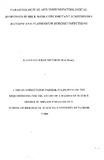Parasitological and immunopathological responses in mice with concomitant schistosoma mansoni and plasmodium berghei infections
Abstract
Usually, areas endemic for schistosomiasis have malarial infections and vice versa.
In Kenya, areas like Mwea, Lake Victoria region, along the coast and Ukambani, are
known for this. On the other hand, not much information is available on the
consequences of having the two infections together. At the same time, study ofthe coinfections
in humans may not allow one to know when the infections started. This
study is therefore aimed at investigating parasitological, pathological and
immunological responses that occur in mice as models for humans, during a
schistosorniasis-malaria co-infection.
A group of mice was infected with S. mansoni and then divided into three separate
groups. At weeks 4, 5, and 6 post-infection, each separate group was super-infected
with P. berghei. There were also uninfected and single-infected controls of both S.
mansoni and P. berghei. At various times post-infection with P. berghei, blood
samples were taken for assays of parasitaemia and immunoglobulin G (IgG). Liver
tissues were also obtained for histopathology, and perfusion done for establishing the
worm burden. The procedures were carried out in the experimental mice and their
controls.
It was found out that mice infected by both parasites developed higher malaria
parasitemia, and showed higher IgG responses compared to the single-infected mice.
It was also noted that the wormload in the S. mansoni-only-infected group was
significantly higher than in the co-infected mice. The granuloma sizes were also
larger in the S. mansoni-only-infected groups as compared to the co-infected groups.
These results were consistent, regardless of whether-the super-infection was done at
week 4, 5, or 6 post- S. mansoni infections, though the difference in worm load at
week 4 was not significant. Taken together, the Eata from this study show that
schistosome and malaria infections profoundly affect each other. These findings may
have implications in the treatment and control of bot~h i.nfections. The results suggest
that co-infections with schistosome and malaria parasites would aggravate malaria
severity. This would necessitate the need for considering schistosome infection in
clinical as well as therapeutic management of malaria patients in areas where the two
diseases are co-endemic. On the other hand, the results indicate that malaria confers
an advantage to the S. mansoni infection, since the granuloma sizes in co-infected
mice were significantly smaller than in the S. mansoni- only infected mice. The worm
burden was also significantly higher in the S. mansoni- only infected mice than in the
co-infected mice. These findings call for a concerted approach in the control of
malaria and schistosomiasis.
Citation
MScPublisher
School of Biological Sciences, University of Nairobi
Description
Masters of Science

